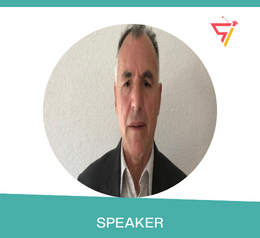Scholars 4th Edition International Conference on
Catalysis and Chemical Engineering
THEME: "Exploring Critical Breakthroughs in Catalysis and Chemical Engineering"
 27-28 Mar 2023
27-28 Mar 2023  Crowne Plaza Ealing, London, UK & Online
Crowne Plaza Ealing, London, UK & Online THEME: "Exploring Critical Breakthroughs in Catalysis and Chemical Engineering"
 27-28 Mar 2023
27-28 Mar 2023  Crowne Plaza Ealing, London, UK & Online
Crowne Plaza Ealing, London, UK & Online 
University of Prishtina
Title: CONSTITUENTS AND POROSITY OF LEAD CONCENTRATE PELLETS PRODUCED IN THE TREPCE PLANT
Professor Ahmet Haxhiaj was entitled PhD by University
of Prishtina, Faculty of Mining and Metalurgy, with topic "Intensify and
Optimize the Reductive Process of Melting the Lead Agglomerate in Port-Piri
Furnace" in 2003. In 1989 he
finished post-graduate studies at University of Zagreb, Faculty of Metallurgy,
Sisak. He studied Metallurgy Science and presented a master thesis in
"Materials and Heat Balance in Port-Piri Furnace". In 1978 graduated
in the topic "Indium Composition in Products and Inter--products of Lead
and Zinc, and Seperation Process of Extracting Indium in Trepça. He currently
lectures in the Department of Metallurgy and Materials, Faculty of Geoscience,
University of Mitrovica and Faculty of Applied Arts at University of Peja. He
published more than 42 papers and is a member of the Alb-shkenca board. Since
2016 is the Editing Chief on IJMPEM "International Journal Minerals
Processing Extractive Metallurgy. In 1983-1993 he worked in the Zastava
laboratory in Peja në thermal processing and was the manager of four projects
in this field. In 1978-1983 he worked in the Lead Metallurgy in Zveqan, Trepça.
Both composition and porosity of pellets are
the main parameters influencing the reductive melting process in water-jacket
furnace during the roasting of sulfide lead concentrate. Roasting in a smelter
located in Trepçë is done at about 9000 C, for pellets which are composed of
PbS, CaCO3, Fe2O3, and SiO2. In order to faciltiate the formation of slag in
the reductive melting, the pellets must have the proper content of CaO, SiO2,
and FeO, and porosity. The plant’s practice indicates that pellets with
porosity of 18% do not melt adequately in the water-jacket furnace. The optimum
porosity for the proper melting of pellets needs to be 32-40% and can be
achieved when pellets are loaded with more than 10 wt.% CaO. Pellets with less
than 10% CaO have a limited network of pores, such that reactive gases cannot
reach the entire ore structure. Also, the composition of the pellets must
satisfy the ratio of CaO : SiO2 : FeO = 1 : 1.2 : 1.8 to facilitate the formation
of slag in the reductive melting process.
Key word, charge, pelletization,
agglomeration, melting, technical Pb, slag